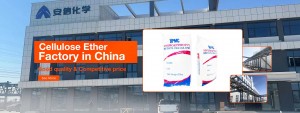Hydroxypropyl Methylcellulose (HPMC) is a non-ionic cellulose ether widely used in cement-based materials such as building mortar, tile adhesive, self-leveling mortar, and cement plaster. Its main function is to improve the workability, water retention, and consistency stability of the mixture. However, as a high-molecular-weight organic additive, HPMC also has a significant impact on the physical and chemical reactions during the cement hydration process.
1. Physicochemical Properties of HPMC
HPMC is a water-soluble polymer formed from natural cellulose through an etherification reaction that introduces methoxy and hydroxypropoxy groups. Its molecular structure contains numerous hydroxyl and ether bonds, enabling it to form a stable hydrogen bond network with water molecules, resulting in excellent water retention and film-forming properties. Its aqueous solution exhibits pseudoplastic fluid characteristics, meaning its viscosity decreases under shear, which is beneficial for construction operations. Due to its non-ionic properties, HPMC interacts relatively mildly with ionic components in cement. However, through physical adsorption and steric hindrance effects, it still influences the hydration process of cement particles.
2. The Influence of HPMC on the Initial Stage of Cement Hydration
In the early stages of cement hydration, HPMC molecules can adsorb onto the surface of cement particles, forming a polymeric film. This film hinders the penetration of water into the cement particles, delaying the dissolution of C₃S (tricalcium silicate) and C₃A (tricalcium aluminate). Studies have shown that the addition of HPMC significantly delays the induction period of cement, shifting the exothermic peak of the system later, resulting in a decrease in the hydration rate.
This delaying effect mainly stems from two aspects:
Physical hindrance: The HPMC film inhibits water diffusion and ion exchange, reducing the formation of early hydration nuclei.
Water absorption competition effect: HPMC has a strong water absorption capacity, competing with cement for free water in the system, leading to a relatively lower effective water-cement ratio, thereby slowing down the hydration reaction rate.
Therefore, in mortar systems containing HPMC, both initial and final setting times are generally prolonged, but this is beneficial for improving workability.
3. The Influence of HPMC on Cement Hydration Products
Although HPMC initially inhibits the hydration reaction, its delaying effect does not destroy the final degree of cement hydration. Over time, HPMC gradually dissolves or disperses in an alkaline environment, disrupting the coating layer and allowing cement hydration to continue.
During later hydration, the structures of products such as hydrated calcium silicate (C-S-H gel) and calcium hydroxide (CH) generated in the system tend to become denser, and the porosity decreases. The water-retaining effect of HPMC ensures the continuity of hydration in a dry environment, thereby promoting the full hydration reaction and reducing the formation of drying shrinkage cracks. Some studies also indicate that HPMC can promote the uniform formation of C-S-H by regulating ion migration and local pH, thus increasing the density of the interfacial layer.
4. Effects of HPMC on Microstructure and Mechanical Properties
The presence of HPMC significantly alters the microstructure of cement paste. Its three-dimensional polymer network helps retain moisture during hardening, resulting in a more uniform distribution of hydration products and a finer pore structure. Scanning electron microscopy (SEM) observations show that cement paste with added HPMC has fewer surface pores and a denser C-S-H gel distribution.
However, the organic properties of HPMC may also weaken the early strength of the hardened body to some extent. This is because in the initial stage, some areas are not fully hydrated, and delayed setting slows down the strength formation rate. However, as the hydration reaction continues, the strength recovers and even slightly improves later. This “early inhibition, later enhancement” pattern is particularly pronounced in low-dosage (<0.5%) HPMC systems.
5. Balance of HPMC Dosage and Effects
The dosage of HPMC is a key factor affecting its effectiveness. Generally, when the HPMC dosage is 0.1%–0.5% of the cement mass, it can significantly improve water retention and workability without excessively inhibiting the hydration process. Excessive dosage may lead to prolonged lag in the hydration reaction, increased porosity of the cement paste, and ultimately, negatively impact mechanical properties.
The degree of substitution (DS), viscosity grade, and molecular weight of HPMC also affect hydration behavior. High-viscosity, high-substitution-degree HPMC has stronger adsorption and barrier effects, resulting in a more significant delay in hydration; while low-viscosity HPMC can balance workability and hardening performance.
HPMC plays a dual role in the hydration process of cement-based materials:
Early stage: It delays the hydration reaction of cement particles through adsorption, film formation, and water absorption, prolonging setting time.
Mid-to-late stage: It promotes continuous hydration through water retention and interfacial regulation, improving structural density and volume stability.
Appropriate dosage and suitable molecular structure of HPMC can not only improve workability but also optimize the microstructure and long-term performance of the cement paste to a certain extent. Therefore, in construction engineering, scientifically controlling the type and dosage of HPMC is the key to achieving a balance and optimization of the performance of cement-based materials.
Post time: Nov-06-2025

